Experimental Investigation on the Mechanical and Physical Properties of Glass/Jute Hybrid Laminates
Abstract
:1. Introduction
2. Materials and Methods
2.1. Materials and Manufacturing
2.2. Laminate Characterization and Properties
3. Results and Discussion
3.1. Physical Properties
3.2. Mechanical Properties
4. Conclusions
Author Contributions
Funding
Institutional Review Board Statement
Informed Consent Statement
Data Availability Statement
Acknowledgments
Conflicts of Interest
References
- Mohammed, L.; Ansari, M.N.M.; Pua, G.; Jawaid, M.; Islam, M.S. A review on natural fibre reinforced polymer composite and its applications. Int. J. Polym. 2015, 2015, 243947. [Google Scholar] [CrossRef] [Green Version]
- Ates, B.; Koytepe, S.; Ulu, A.; Gürses, C.; Thakur, V.K. Chemistry, Structures, and Advanced Applications of Nanocomposites from Biorenewable Resources. Chem. Rev. 2020, 120, 9304–9362. [Google Scholar] [CrossRef] [PubMed]
- Ameer, M.H.; Nawab, Y.; Ali, Z.; Imad, A.; Ahmad, S. Development and characterization of jute/polypropylene composite by using comingled nonwoven structures. J. Text. Inst. 2019, 110, 1652–1659. [Google Scholar] [CrossRef]
- Xiao, Z.; Pei, L.; Zhang, F.; Sun, Y.; Geng, L.; Wu, J.; Tong, J. Parameter Measurement of Biaxial Braided Composite Preform Based on Phase Congruency. Autex Res. J. 2019, 19, 8–16. [Google Scholar] [CrossRef] [Green Version]
- Ashir, M.; Nocke, A.; Cherif, C. Effect of the Position of Defined Local Defect on the Mechanical Performance of Carbon-Fibre-Reinforced Plastics. Autex Res. J. 2019, 19, 74–79. [Google Scholar] [CrossRef] [Green Version]
- Wahab, N.; Srinophakun, P.; Hussain, Q.; Chaimahawan, P. Performance of Concrete Confined with a Jute–Polyester Hybrid Fibre Reinforced Polymer Composite: A Novel Strengthening Technique. Fibres 2019, 7, 72. [Google Scholar] [CrossRef] [Green Version]
- Singha, A.; Thakur, V.K. Fabrication and characterization of H. sabdariffa fibre-reinforced green polymer composites. Polym.-Plast. Technol. Eng. 2009, 48, 482–487. [Google Scholar] [CrossRef]
- Jayaraman, K. Manufacturing sisal–polypropylene composites with minimum fibre degradation. Compos. Sci. Technol. 2003, 63, 367–374. [Google Scholar] [CrossRef]
- Tripathi, P.; Gupta, V.K.; Dixit, A.; Misra, R.K. Development and characterization of low cost jute, bagasse and glass fibre reinforced advanced hybrid epoxy composites. AIMS Mater. Sci. 2018, 5, 320–337. [Google Scholar] [CrossRef]
- Rahman, R.; Huque, M.; Islam, N.; Hasan, M. Improvement of physico-mechanical properties of jute fibre reinforced polypropylene composites by post-treatment. Compos. Part A Appl. Sci. Manuf. 2008, 39, 1739–1747. [Google Scholar] [CrossRef]
- Das, S. Mechanical properties of waste paper/jute fabric reinforced polyester resin matrix hybrid composites. Carbohydr. Polym. 2017, 172, 60–67. [Google Scholar] [CrossRef] [PubMed]
- Hasan, M.; Saifullah, A.; Dhakal, H.N.; Khandaker, S.; Sarker, F. Improved mechanical performances of unidirectional jute fibre composites developed with new fibre architectures. RSC Adv. 2021, 11, 23010–23022. [Google Scholar] [CrossRef] [PubMed]
- Baley, C.; Lan, M.; Bourmaud, A.; Le Duigou, A. Compressive and tensile behaviour of unidirectional composites reinforced by natural fibres: Influence of fibres (flax and jute), matrix and fibre volume fraction. Mater. Today Commun. 2018, 16, 300–306. [Google Scholar] [CrossRef]
- Das, S. Mechanical Properties of Unidirectional Jute-Polyester Composite. J. Text. Sci. Eng. 2015, 5, 1. [Google Scholar] [CrossRef] [Green Version]
- Ashish; Rakesh; Kumar, S. Experimental and theoretical investigation of Young’s modulus of uni-directional jute/epoxy composite laminates with different fibre volume fraction. Int. J. Appl. Eng. Res. 2018, 13, 14382–14385. [Google Scholar]
- Ali, Y.; Faisal, A.; Saifullah, A.; Dhakal, H.N.; Alimuzzaman, S.; Sarker, F. Fabrication and Mechanical Performance of Non-Crimp Unidirectional Jute-Yarn Preform-Based Composites. Molecules 2021, 26, 6664. [Google Scholar] [CrossRef] [PubMed]
- Motaleb, K.A.; Milašius, R.; Ahad, A. Influence of Gamma Radiation on Mechanical Properties of Jute Fabric-Reinforced Polymer Composites. Fibers 2020, 8, 58. [Google Scholar] [CrossRef]
- Mitra, B.; Basak, R.; Sarkar, M. Studies on jute-reinforced composites, its limitations, and some solutions through chemical modifications of fibres. J. Appl. Polym. Sci. 1998, 67, 1093–1100. [Google Scholar] [CrossRef]
- Das, S.; Singha, A.K.; Chaudhuri, A.; Ganguly, P.K. Lengthwise jute fibre properties variation and its effect on jute–polyester composite. J. Text. Inst. 2019, 110, 1695–1702. [Google Scholar] [CrossRef]
- Faizi, M.; Shahriman, A.; Majid, M.S.A.; Shamsul, B.; Ng, Y.G.; Basah, S.; Cheng, E.; Afendi, M.; Zuradzman, M.; Wan, K.; et al. An overview of the Oil Palm Empty Fruit Bunch (OPEFB) potential as reinforcing fibre in polymer composite for energy absorption applications. MATEC Web Conf. 2017, 90, 1064. [Google Scholar] [CrossRef] [Green Version]
- Kanitkar, Y.M.; Kulkarni, A.P.; Wangikar, K.S. Characterization of Glass Hybrid composite: A Review. Mater. Today Proc. 2017, 4, 9627–9630. [Google Scholar] [CrossRef]
- Kistaiah, N.; Kiran, C.U.; Reddy, G.R.; Rao, M.S. Mechanical characterization of hybrid composites: A review. J. Reinf. Plast. Compos. 2014, 33, 1364–1372. [Google Scholar] [CrossRef]
- Jha, K.; Samantaray, B.B.; Tamrakar, P. A study onerosion and mechanical behavior of jute/E-glass hybrid composite. Mater. Today Proc. 2018, 5, 5601–5607. [Google Scholar] [CrossRef]
- Kaviti, A.K.; Sravani, K.; Namala, K.K.; Gupta, G.S.; Thakur, A.K. Effect of dual resin on mechanical properties of jute glass fibre reinforced hybrid composites. Mater. Res. Express 2020, 6, 12. [Google Scholar] [CrossRef]
- Khalid, M.Y.; Al Rashid, A.; Arif, Z.U.; Sheikh, M.F.; Arshad, H.; Nasir, M.A. Tensile strength evaluation of glass/jute fibres reinforced composites: An experimental and numerical approach. Results Eng. 2021, 10, 100232. [Google Scholar] [CrossRef]
- Chen, Y.; Ye, L.; Fu, K. Progressive failure of CFRP tubes reinforced with composite sandwich panels: Numerical analysis and energy absorption. Compos. Struct. 2021, 263, 113674. [Google Scholar] [CrossRef]
- Chen, Y.; Ye, L.; Escobedo-Diaz, J.P.; Zhang, Y.X. Effect of initiator geometry on energy absorption of CFRP tubes under dynamic crushing. Int. J. Crashworthiness 2020, 26, 526–536. [Google Scholar] [CrossRef]
- Mohd Hashim, K.R.; Abdul Majid, M.S.; Mohd Jamir, M.R.; Kasim, F.H.; Hameed Sultan, M.T. The Effect of Stacking Sequence and Ply Orientation on the Mechanical Properties of Pineapple Leaf Fibre (PALF)/Carbon Hybrid Laminate Composites. Polymers 2021, 13, 455. [Google Scholar] [CrossRef]
- Ouarhim, W.; Essabir, H.; Bensalah, M.-O.; Rodrigue, D.; Bouhfid, R.; Qaiss, A.E.K. Hybrid composites and intra-ply hybrid composites based on jute and glass fibers: A comparative study on moisture absorption and mechanical properties. Mater. Today Commun. 2020, 22, 100861. [Google Scholar] [CrossRef]
- Sujon, A.S.; Habib, M.A.; Abedin, M.Z. Experimental investigation of the mechanical and water absorption properties on fiber stacking sequence and orientation of jute/carbon epoxy hybrid composites. J. Mater. Res. Technol. 2020, 9, 10970–10981. [Google Scholar] [CrossRef]
- Vinod, A.; Tengsuthiwat, J.; Gowda, Y.; Vijay, R.; Sanjay, M.R.; Siengchin, S.; Dhakal, H.N. Jute/hemp bio-epoxy hybrid bio-composites: Influence of stacking sequence on adhesion of fibre-matrix. Int. J. Adhes. Adhes. 2022, 113, 103050. [Google Scholar] [CrossRef]
- Ganesan, K.; Kailasanathan, C.; Rajini, N.; Ismail, S.O.; Ayrilmis, N.; Mohammad, F.; Al-Lohedan, H.A.; Tawfeek, A.M.; Issa, Z.A.; Aldhayan, D.M. Assessment on hybrid jute/coir fibers reinforced polyester composite with hybrid fillers under different environmental conditions. Constr. Build. Mater. 2021, 301, 124117. [Google Scholar] [CrossRef]
- Trindade, R.S.; Ribeiro, A.C.; Souza, J.A.; Amico, S.C. Experimental investigation of transverse permeability applied to liquid molding. Polym. Compos. 2019, 40, 3938–3946. [Google Scholar] [CrossRef]
- Kaw, A.K. Mechanics of Composite Materials, 2nd ed.; Taylor and Francis Group, LLC.: New York, NY, USA, 2006. [Google Scholar]
- Jawaid, M.; Abdul Khalil, H.P.S. Cellulosic/synthetic fibre reinforced polymer hybrid composites: A review. Carbohydr. Polym. 2011, 86, 1–18. [Google Scholar] [CrossRef]
- Amico, S.C.; Menezes, E.A.W. MECH-Gcomp, UFRGS. Available online: www.ufrgs.br/mechg. (accessed on 18 June 2020).
- Fiore, L.V.; Calabrese, R.; Miranda, D.; Badagliacco, C.; Sanfilippo, D.; Palamara, A.; Valenza, E.P. Assessment of performance degradation of hybrid flax-glass fibre reinforced epoxy composites during a salt spray fog/dry aging cycle. Compos. Part B Eng. 2022, 238, 109897. [Google Scholar] [CrossRef]
- Mehdikhani, M.; Gorbatikh, L.; Verpoest, I.; Lomov, S.V. Voids in fiber-reinforced polymer composites: A review on their formation, characteristics, and effects on mechanical performance. J. Compos. Mater. 2018, 53, 1579–1669. [Google Scholar] [CrossRef]
- Laranjeira, E.; Carvalho, L.H.; de Silva, S.M.; D’Almeida, J.R.M. Influence of fibre orientation on the mechanical properties of polyester/jute composites. J. Reinf. Plast. Compos. 2006, 25, 1269–1278. [Google Scholar] [CrossRef]
- Oliveira, F.H.; Amico, S.C.; Helfer, A.L.; Amico, S.C. Mechanical behavior of unidirectional curaua fibre and glass fibre composites. Macromol. Symp. 2012, 319, 83–92. [Google Scholar] [CrossRef]
- Fajrin, J.; Herlina Sari, N. Shear properties evaluation of natural fibre reinforced epoxy composites using V-notch shear test. In MATEC Web of Conferences; Anais; EDP Sciences: Les Ulis, France, 2018; Volume 95, pp. 1–7. [Google Scholar]
- Torabizadeh, M.A. Tensile, compressive and shear properties of unidirectional glass/epoxy composites subjected to mechanical loading and low temperature services. Indian J. Eng. Mater. Sci. 2013, 20, 299–309. [Google Scholar]
- Zhang, Y.; Li, Y.; Ma, H.; Yu, T. Tensile and interfacial properties of unidirectional flax/glass fibre reinforced hybrid composites. Compos. Sci. Technol. 2013, 88, 172–177. [Google Scholar] [CrossRef]
- Abdullah-Al-Kafi; Abedin, M.Z.; Beg, M.D.H.; Pickering, K.L.; Khan, M.A. Study on the Mechanical Properties of Jute/Glass Fibre-reinforced Unsaturated Polyester Hybrid Composites Effect of Surface Modification by Ultraviolet Radiation. J. Reinf. Plast. Compos. 2006, 25, 25–37. [Google Scholar] [CrossRef]
- Khan, M.A.; Hasan, M.M. Surface Modification of Natural Fibres by Photo-grafting and Photo-curing. In Polymer Surface Modification: Relevance to Adhesion; Mital, K.L., Ed.; VSP: Rancho Cordova, CA, USA, 2004; Volume 3, pp. 263–283. [Google Scholar]
- Sreekala, M.; George, J.; Kumaran, M.; Thomas, S. The mechanical performance of hybrid phenol-formaldehyde-based composites reinforced with glass and oil palm fibres. Compos. Sci. Technol. 2002, 62, 339–353. [Google Scholar] [CrossRef]
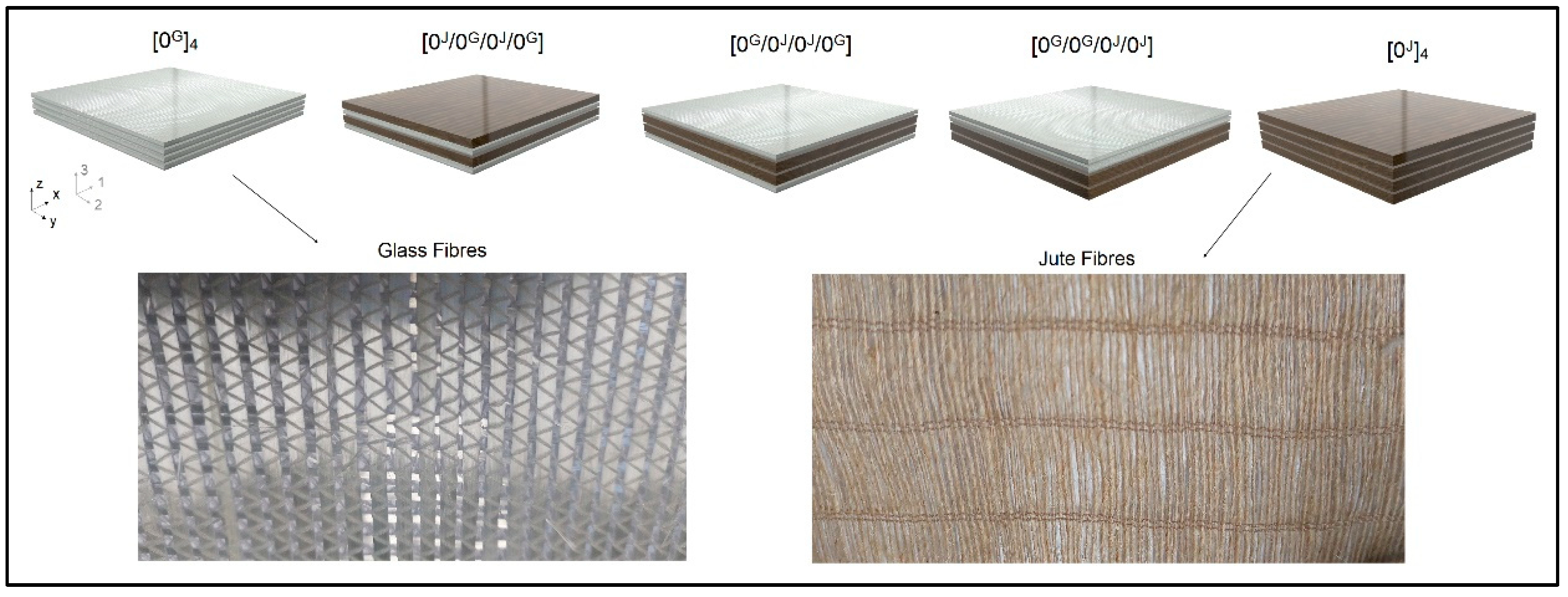
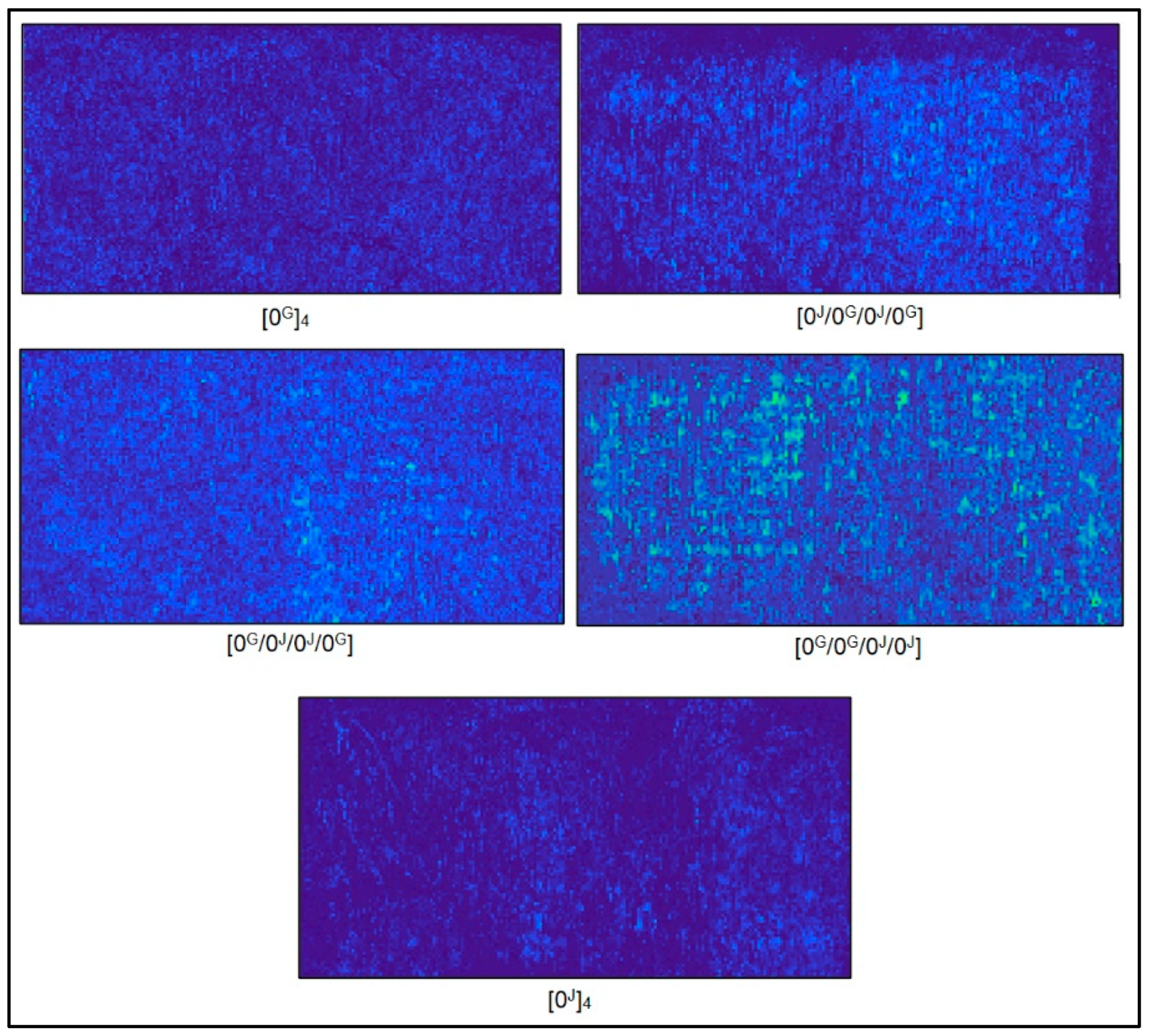
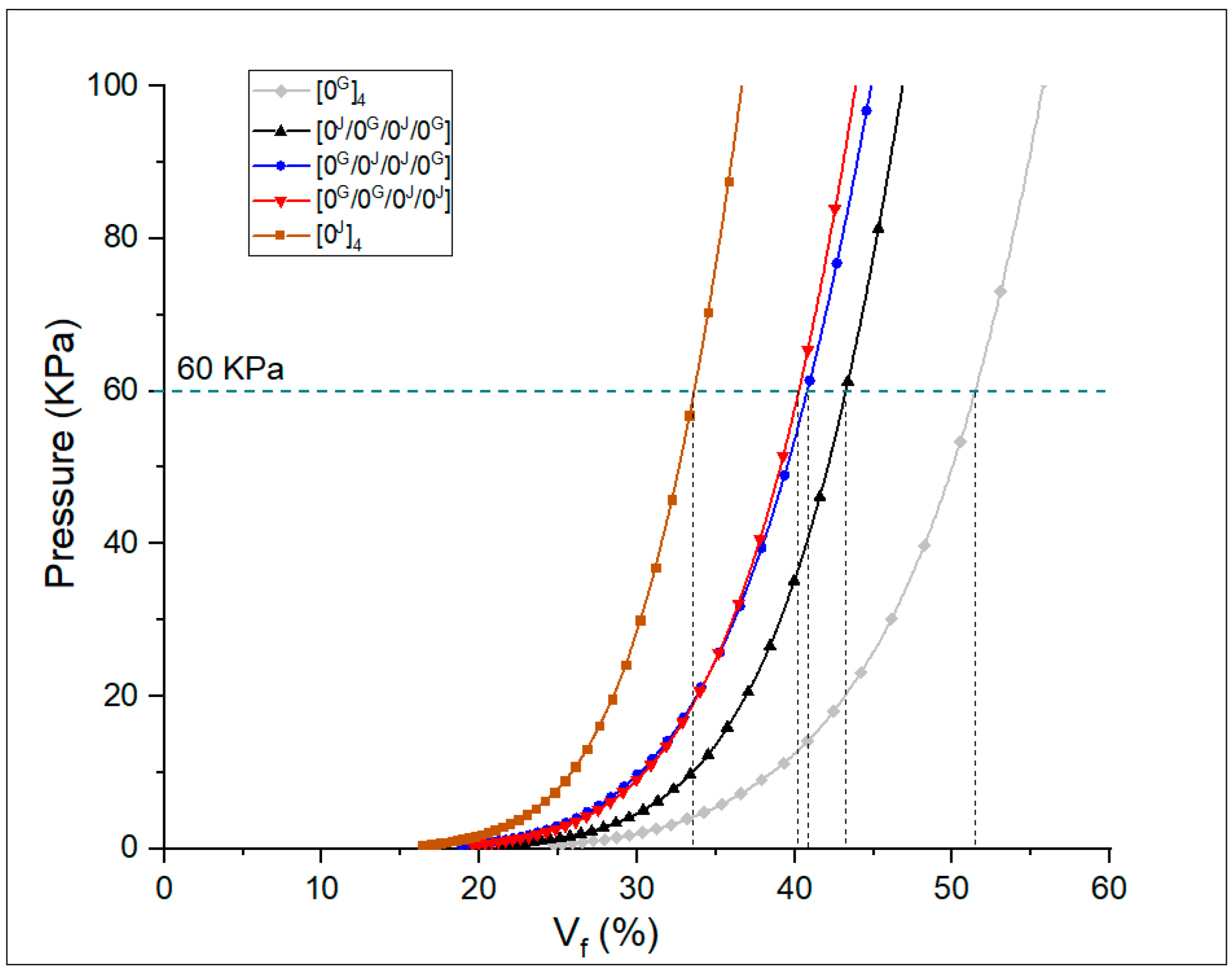

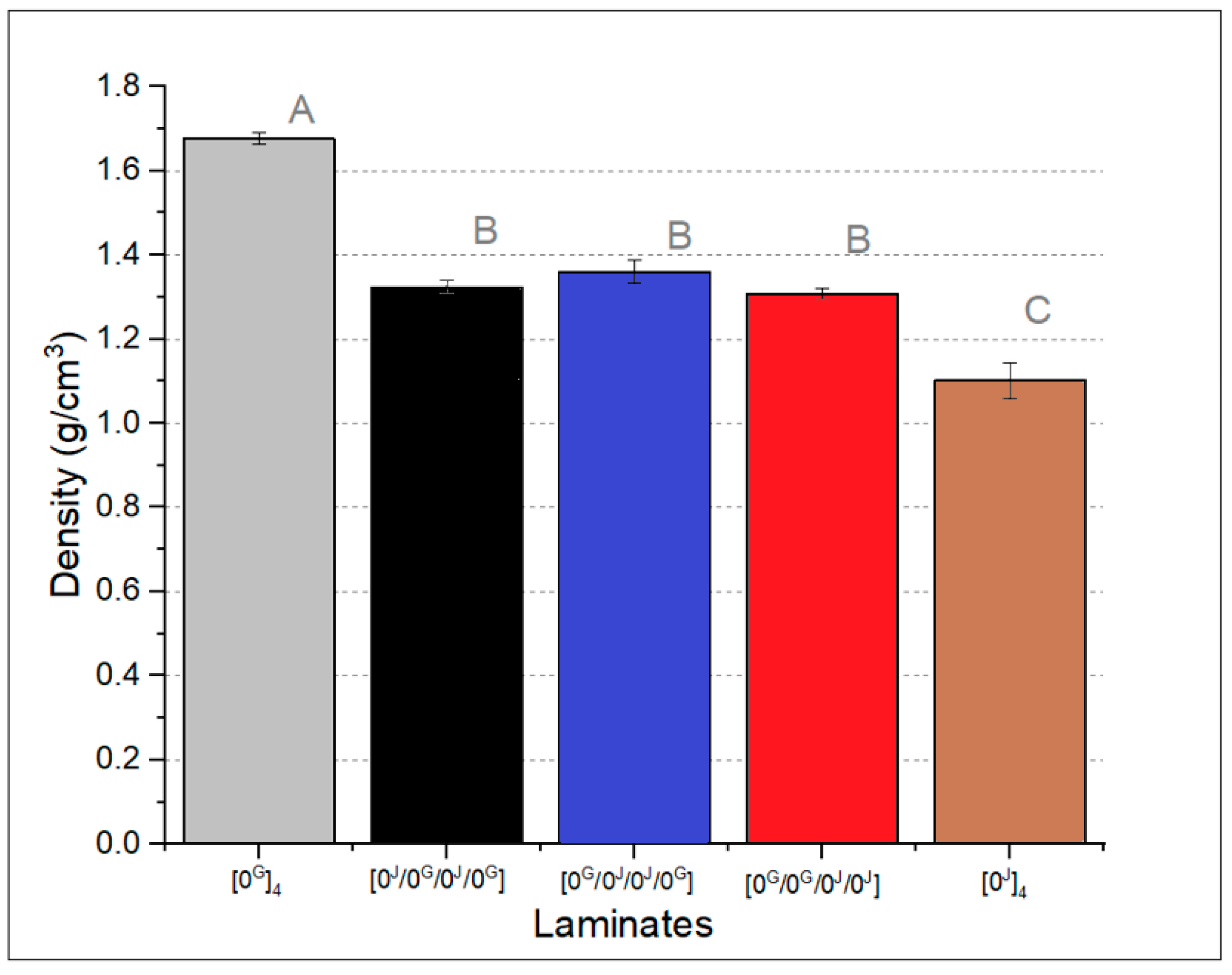
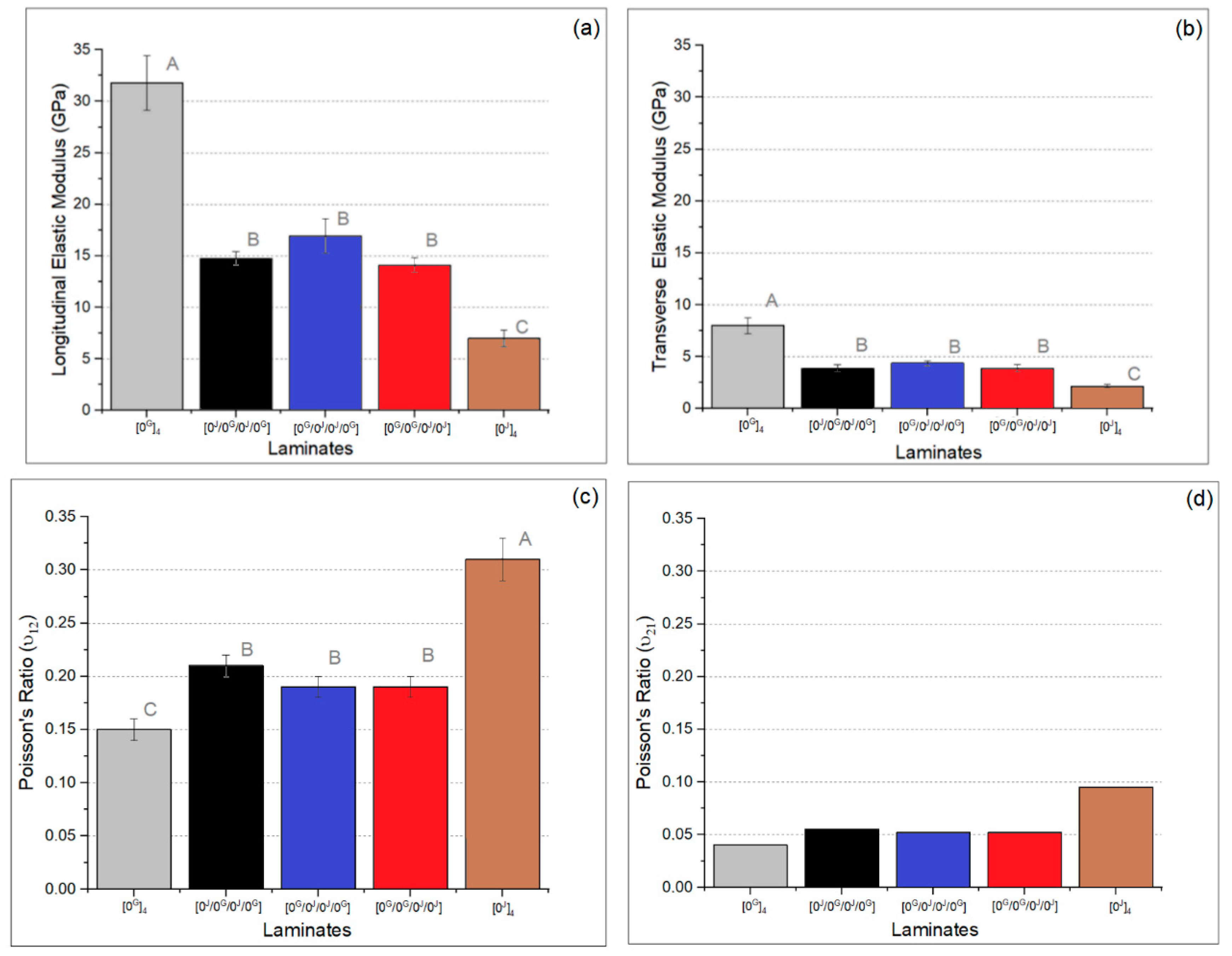
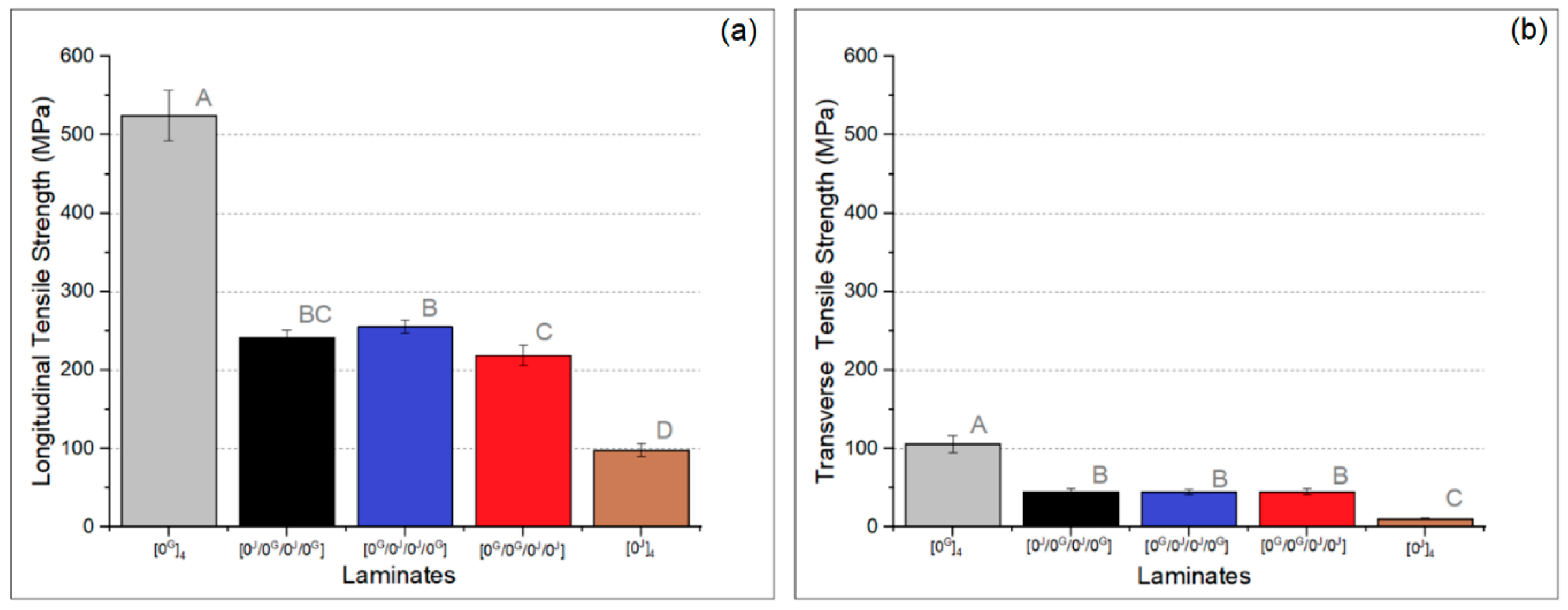
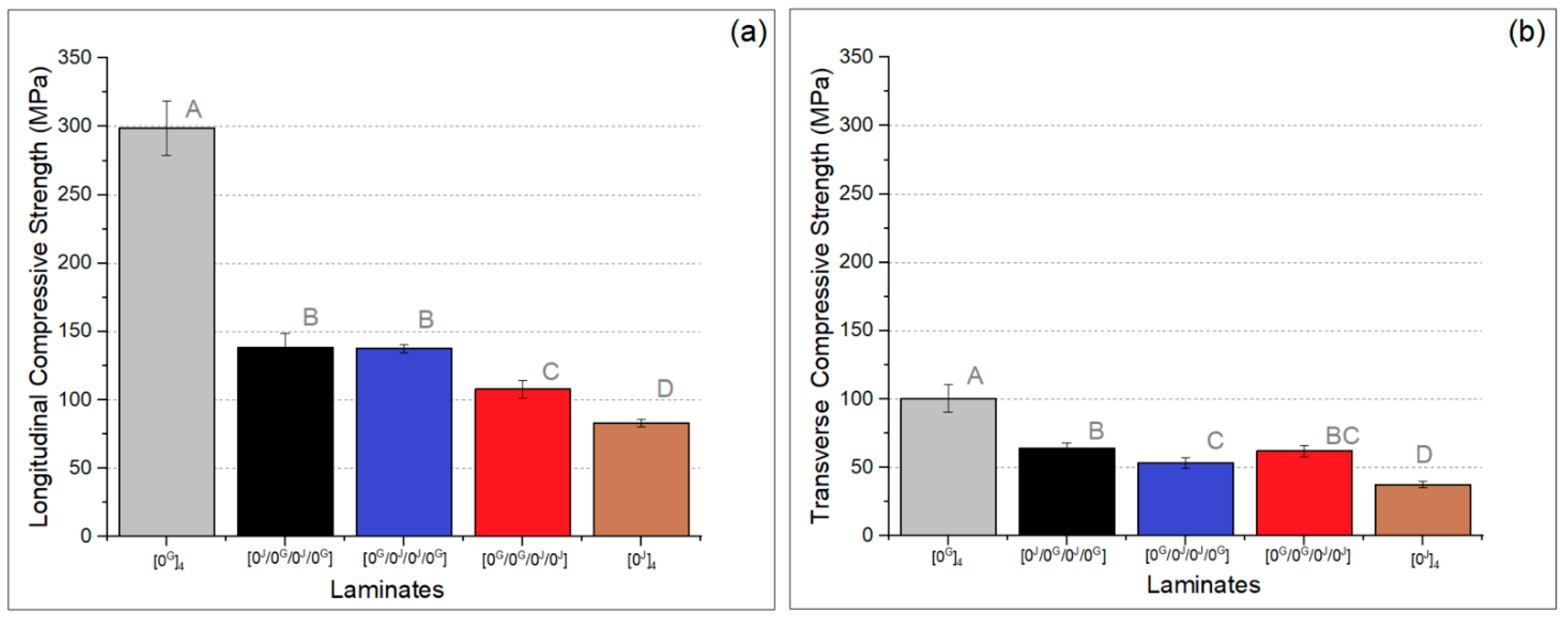

| [0G]4 | [0J/0G/0J/0G] | [0G/0J/0J/0G] | [0G/0G/0J/0J] | [0J]4 | |
|---|---|---|---|---|---|
| VJ (%) | 0.00 | 17.00 | 17.71 | 17.51 | 28.00 |
| VG (%) | 54.14 | 20.00 | 20.69 | 20.46 | 0.00 |
| Vf (%) | 54.14 | 37.00 | 38.40 | 37.97 | 28.00 |
| Vm (%) | 37.31 | 51.98 | 49.84 | 49.03 | 56.41 |
| Vv (%) | 8.55 | 11.02 | 11.76 | 13.00 | 15.59 |
| Layers | [0G]4 | [0J/0G/0J/0G] | [0G/0J/0J/0G] | [0G/0G/0J/0J] | [0J]4 |
|---|---|---|---|---|---|
| 1 | 0.31 | 0.61 | 0.27 | 0.30 | 0.66 |
| 2 | 0.38 | 0.32 | 0.54 | 0.22 | 0.56 |
| 3 | 0.33 | 0.56 | 0.65 | 0.60 | 0.47 |
| 4 | 0.31 | 0.33 | 0.28 | 0.64 | 0.51 |
| Overall | 1.33 | 1.82 | 1.74 | 1.76 | 2.20 |
| Ex (MPa) | Ey (MPa) | Gxy (MPa) | |||
|---|---|---|---|---|---|
| Experimental | 16.93 ± 1.68 | 4.36 ± 0.54 | --- | 0.19 ± 0.01 | 0.08 ± 0.005 |
| Analytical | 16.30 | 4.34 | 3.76 | 0.20 | 0.05 |
Publisher’s Note: MDPI stays neutral with regard to jurisdictional claims in published maps and institutional affiliations. |
© 2022 by the authors. Licensee MDPI, Basel, Switzerland. This article is an open access article distributed under the terms and conditions of the Creative Commons Attribution (CC BY) license (https://creativecommons.org/licenses/by/4.0/).
Share and Cite
Dias, T.d.C.; Silva, A.A.X.d.; Tonatto, M.L.P.; Amico, S.C. Experimental Investigation on the Mechanical and Physical Properties of Glass/Jute Hybrid Laminates. Polymers 2022, 14, 4742. https://doi.org/10.3390/polym14214742
Dias TdC, Silva AAXd, Tonatto MLP, Amico SC. Experimental Investigation on the Mechanical and Physical Properties of Glass/Jute Hybrid Laminates. Polymers. 2022; 14(21):4742. https://doi.org/10.3390/polym14214742
Chicago/Turabian StyleDias, Thaís da Costa, Amanda Albertin Xavier da Silva, Maikson Luiz Passaia Tonatto, and Sandro Campos Amico. 2022. "Experimental Investigation on the Mechanical and Physical Properties of Glass/Jute Hybrid Laminates" Polymers 14, no. 21: 4742. https://doi.org/10.3390/polym14214742
APA StyleDias, T. d. C., Silva, A. A. X. d., Tonatto, M. L. P., & Amico, S. C. (2022). Experimental Investigation on the Mechanical and Physical Properties of Glass/Jute Hybrid Laminates. Polymers, 14(21), 4742. https://doi.org/10.3390/polym14214742








